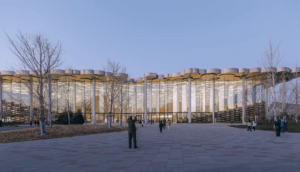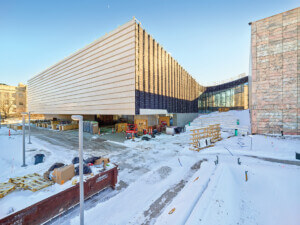San Franciscans have already marked their calendars for the May 14 opening of in downtown San Francisco. The 1995 striated-brick building is being greatly expanded and reorganized in a scheme that triples the museum’s exhibition space while adding a new main entry along Howard Street. The project was developed as a public-private partnership with the Doris and Donald Fisher Collection, which agreed to display works from its private collection at SFMOMA for the next 100 years.
The 10-story, 235,000-square-foot expansion by the Norwegian firm is set back from the Botta structure, adding a funny hat to an already funnily hatted building. Craig Dykers, co-founding partner of Snøhetta, said in a statement that he wanted the new addition to “rise like a continuation of the [original building’s] terraces, even while offering a new image that reflects the Bay Area’s natural setting.” New and old meet at a two-foot-wide seismic joint separating the two structures so that in the event of California’s next “Big One,” each building will be able to jostle independently, minimizing damage.
The new, rectangular structure meets the narrower Botta building along an entire facade, running across the block’s full width, from Minna Street to Howard. The latter entrance is flanked by a two-story grow wall containing 16,000 plants that runs along an interior courtyard resulting from the main building’s stepped facade. Maple-surface amphitheater seating and Richard Serra’s monumental Sequence sculpture are located on the ground floor and adjacent to this courtyard. These features help pull the public into the museum’s first two floors, which will be free to all.
The addition’s facade is clad in 700 custom fiberglass reinforced polymer (FRP) panels that project from the curtain wall. These panels are rumpled horizontally, creating an articulated facade that folds in and out of the ascending mass. Panels incorporate silicate crystals taken from nearby Monterey Bay in order to dapple light along this east-facing exposure.
The remaining entrance along Third Street leads to the original building’s giant, oculus-topped atrium. Here, Botta’s grand staircase, no longer up to code, has been completely removed, allowing the oculus to fill the massive hall with light. This begs the question: with the impending opening of what will be the country’s biggest modern art museum, is it morning in San Francisco?










